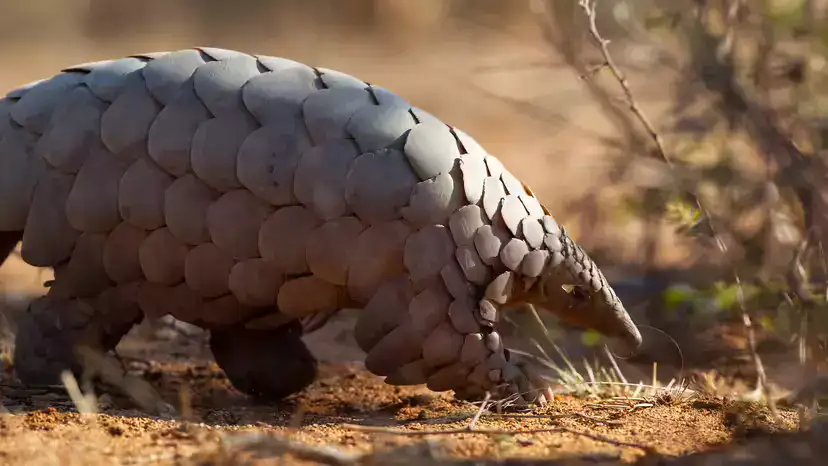All eight species are threatened (IUCN: from Vulnerable to Critically Endangered) and heavily targeted by illegal trade.
Primary pressures: hunting for meat and scales (touted in some traditional remedies) and ongoing habitat loss.
Protection is growing (CITES Appendix I, national laws), but demand-side reduction and smarter enforcement are still crucial.

Pangolins belong to the order Pholidota and family Manidae (8 living species). Their bodies are covered in keratin scales; when threatened they roll into a tight ball, using the sharp scales as armor.
Name origin: Pangolin derives from Malay for “to roll up.”
Not anteaters: Despite the nickname “scaly anteater,” pangolins are not close relatives of New World anteaters.
Size & build: Typical total length 30–100 cm (1–3 ft), tail 25–71 cm, mass 4.5–27 kg. Long, tapered snout; almost toothless; extremely long, sticky tongue that reaches into nests; powerful foreclaws for ripping into mounds.
Asia (4)
Sunda (Malayan) Pangolin (Manis javanica) – CR
Chinese Pangolin (Manis pentadactyla) – CR
Philippine Pangolin (Manis culionensis) – CR
Indian Pangolin (Manis crassicaudata) – EN
Africa (4)
5. White-bellied Pangolin (Phataginus tricuspis) – EN
6. Black-bellied Pangolin (Phataginus tetradactyla) – VU
7. Temminck’s Ground Pangolin (Smutsia temminckii) – VU
8. Giant Ground Pangolin (Smutsia gigantea) – EN
Niche notes: some are arboreal (e.g., black-bellied, Chinese), others terrestrial (e.g., giant ground). Where ranges overlap, they partition time and microhabitats.
Asia: South and Southeast Asia to southern China and the Himalayan foothills; the Philippine species is island-restricted.
Africa: Widespread across sub-Saharan regions.
Habitats: Tropical rainforests, seasonal forests, savannas, mosaics of farmland and secondary woodland.
Habitat needs: Stable ant/termite resources, diggable soils or tree cavities, and low nocturnal disturbance.
Core prey: Termites, ants, and their brood; occasionally other arthropods.
Foraging: Locates nests by smell → tears them open with claws → feeds using the sticky tongue (up to ~25 cm / 10 in).
Digestive traits: Thickened stomach wall, ingested grit to macerate food; minimal chewing.
Mostly solitary and nocturnal; strong territorial behavior; daytimes spent in burrows or tree hollows.
Breeding: Most species produce one pup per litter (occasionally 1–3). Gestation is several months; the young ride on the mother’s back or tail and wean after a few months.
Natural predators: Big cats, hyenas, large raptors—though human hunting dwarfs natural predation.
Critically Endangered (CR): Chinese, Philippine, Sunda
Endangered (EN): Indian, White-bellied, Giant Ground
Vulnerable (VU): Black-bellied, Temminck’s
Why so high-risk?
Overexploitation for meat (luxury cuisine) and scales (promoted in some traditional pharmacopeias despite lack of robust clinical evidence).
International trafficking networks now pull heavily from African populations in addition to Asia.
Habitat loss and fragmentation compound pressures.
CITES (2016): All pangolins and their parts listed on Appendix I (international commercial trade banned).
National measures: Up-listing to top protection classes, stronger penalties, smarter customs screening.
What works best is a combined strategy:
Source: community co-management and alternative livelihoods;
Transit: intelligence-led operations against trafficking routes and warehousing;
Demand: public education, healthcare guidance on evidence-based alternatives, and compliance within food & medicine sectors.
“Scales cure many diseases” → Pangolin scales are keratin, like human nails/hair; there’s no proven broad medical efficacy.
“Captive breeding will replace wild supply soon” → Pangolins are extremely challenging to maintain and breed (diet, stress, disease). Large-scale captive production is not a near-term fix for illegal demand.
Never buy pangolin meat, scales, or curios—online or offline.
Report suspected trafficking posts and listings.
Support vetted projects funding anti-poaching patrols, rescue/rehab, habitat restoration, and community livelihoods.
Share evidence-based information to counter misinformation.
How do pangolins defend themselves?
They rapidly curl into a tight ball, shielding soft parts with hard scales; tails and dorsal scales resist bites and claws.
What conservation actions are most effective?
A “triple lock” of international bans + national enforcement + demand reduction, supported by border intelligence, case tracing, habitat connectivity, and community incentives.
Are all species equally threatened?
Pressures vary by region, but globalized trafficking means all eight species face sustained risk; current Red List categories can worsen if demand persists.
animal tags: pangolin
We created this article in conjunction with AI technology, then made sure it was fact-checked and edited by a Animals Top editor.